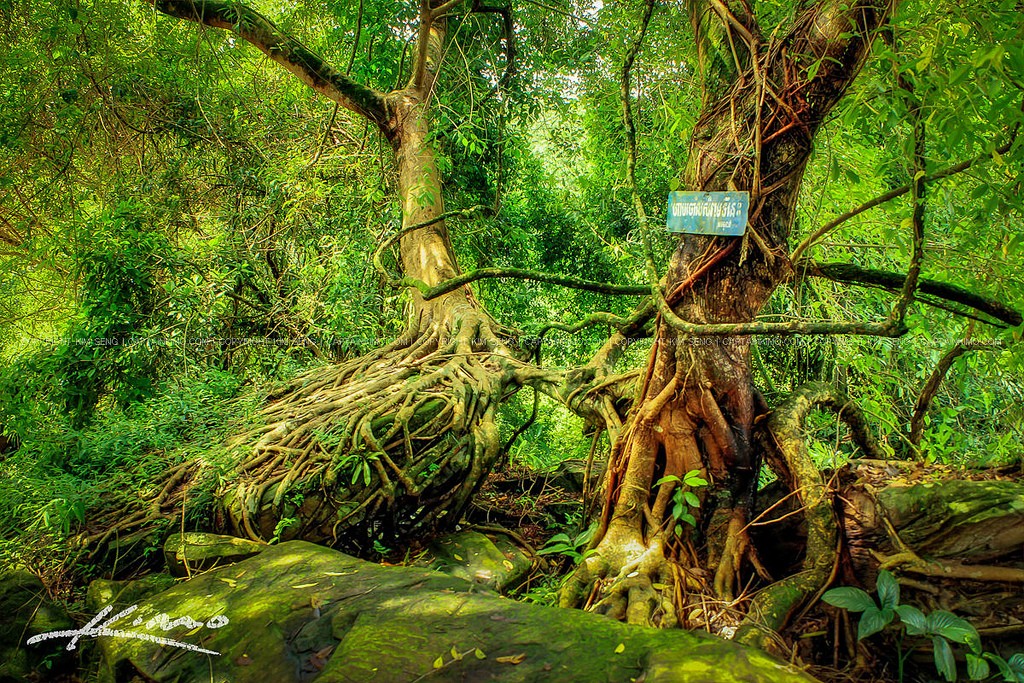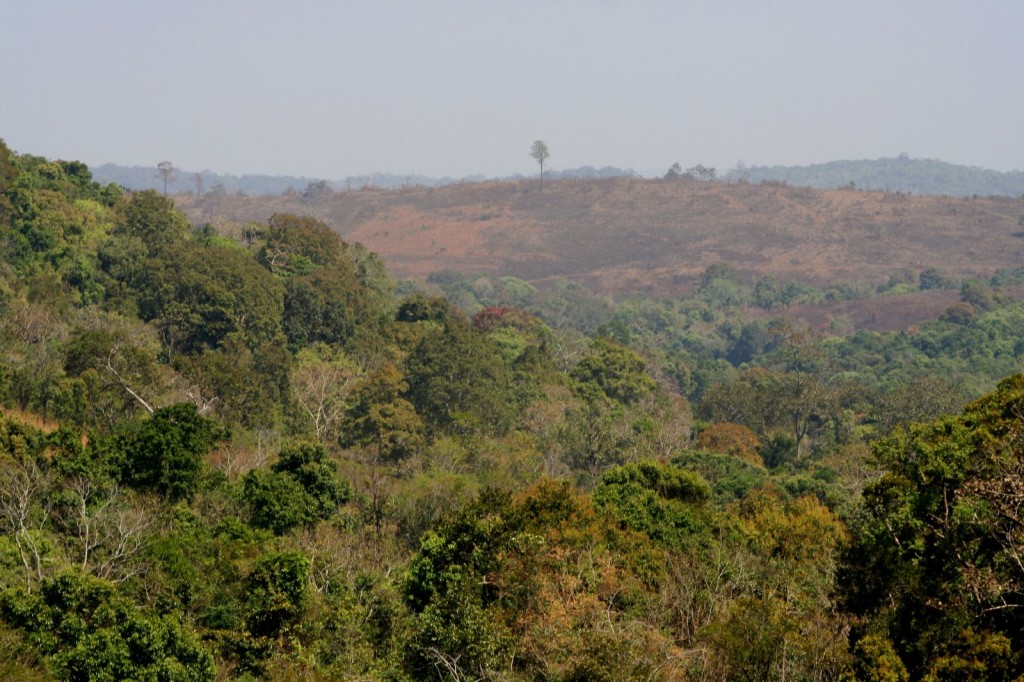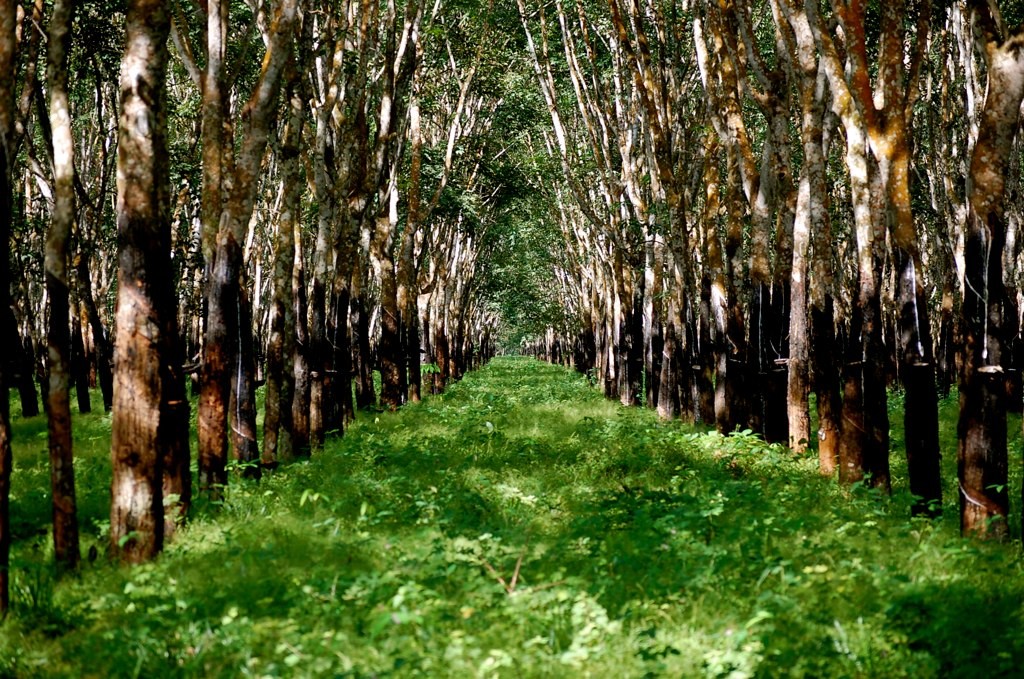ការកំណត់និយមន័យ និងការវាស់ព្រៃឈើ គឺមិនមែនជារឿងងាយស្រួលនោះឡើយ។ និយមន័យដែលមានសភាពស្រដៀងគ្នាខ្លាំង ក៏អាចនឹងមានភាពខុសគ្នា គួរឱ្យកត់សំគាល់។ ការយល់ដឹងពីលក្ខខណ្ឌ គឺមានសារៈសំខាន់សម្រាប់ការយល់ដឹងអំពីការប្រើប្រាស់ព្រៃឈើ គម្របព្រៃឈើ ច្បាប់និងគោលនយោបាយព្រៃឈើ និងការកាប់បំផ្លាញព្រៃឈើ។
ព្រៃនៅក្បាលឆាយ ខេត្តព្រះសីហនុ នៃប្រទេសកម្ពុជា។ រូបភាព ថតដោយ Kim Seng, ១៧ ធ្នូ ២០១១។ ក្រោមអាជ្ញាប័ណ្ណ CC BY-NC-ND 2.0។
ការដាំដើមឈើជាថ្មី
ការបម្លែងដីឱ្យក្លាយទៅជាព្រៃ ឬ បង្កើនគម្របកាណូភីឱ្យច្រើនជាង ១០ ភាគរយ។
កាណូភី
ស្រទាប់នៃស្លឹក ដើម និងមែក របស់ដើមឈើ ដែលគ្របដណ្តប់ទិដ្ឋភាពនៃដី នៅពេលមើលពីខាងលើ។ ជារឿយៗ ក្នុងការពិពណ៌នាជាភាគរយ គម្របកាណូភី ៥០ ភាគរយ មានន័យថា ដីប្រមាណ ៥០ ភាគរយ មិនអាចត្រូវបានគេមើលឃើញ ដោយសារតែដើមឈើ។
ព្រៃឈើបិទ
ព្រៃឈើ ដែលគ្របដណ្តប់ដោយកាណូភីដើមឈើ ៦០ ទៅ ១០០ ភាគរយ។
ព្រៃល្បោះ
ព្រៃឈើ ដែលតែងតែជម្រុះស្លឹក និងលូតលាស់ឡើងវិញទៅតាមរដូវកាល។
ការកាប់បំផ្លាញព្រៃឈើ
ការបម្លែងព្រៃឈើ ទៅជាការប្រើប្រាស់ដីផ្សេងទៀត ឬ ការកាត់បន្ថយរយៈពេលវែងនៃកាណូភីព្រៃឈើ ដែលគ្របដណ្តប់កម្រិតអប្បបរមា ១០ ភាគរយ។ ការឈូសឆាយ ឬ ការប្រមូលផលឈើពីតំបន់ព្រៃ មិនត្រូវបានចាត់ទុកថាជា ការកាប់បំផ្លាញព្រៃឈើ ប្រសិនបើការប្រើប្រាស់ដីមិនផ្លាស់ប្តូរភ្លាមៗ។
ព្រៃស្រោង
តំបន់ដែលបានចាត់ថ្នាក់ជាព្រៃស្រោងនៅក្នុងផែនទីរបស់ ODC រួមមានព្រៃបៃតងជានិច្ច និងព្រៃពាក់កណ្តាលបៃតង ដូចដែលបានកំណត់នៅក្នុងឯកសារ គម្របព្រៃឈើកម្ពុជា បោះពុម្ពដោយរដ្ឋបាលព្រៃឈើ (ខែមិថុនា ឆ្នាំ២០១០)។ ព្រៃស្រោងភាគច្រើន មានទីតាំងខ្ពស់ជាង ៥០០ ម៉ែត្រ។ ព្រៃស្រោង អាចហៅម៉្យាងទៀតថា ព្រៃលូតលាស់ចាស់ (old-growth forest)។ និយមន័យនេះបង្ហាញពីសញ្ញាកំណត់នៃការកាន់កាប់របស់មនុស្ស ដូចជា ការតាំងទីលំនៅតូចៗរបស់ជនជាតិដើមភាគតិចនៅក្នុងព្រៃ (ខណៈដែល និយមន័យនៃព្រៃបឋម មិនមានពណ៌នា)។ ជាផ្នែកមួយនៃការវិភាគឯករាជ្យភាពរបស់ទិន្នន័យគម្របព្រៃឈើរបស់ ODC ក្នុងឆ្នាំ២០១៤, អង្គការឃ្លាំមើលព្រៃឈើជាសកល បានថ្លែងថា គម្របព្រៃស្រោងមានកាណូភីដើមឈើធំជាង ៦០ ភាគរយ។
ព្រៃបៃតងជានិច្ច
ព្រៃឈើ ដែលមានដើមឈើ ដែលមិនមានការបាត់បង់ស្លឹក និងលូតលាស់ស្លឹកឡើងវិញ ទៅតាមរដូវកាល។
ព្រៃឈើ
ដីដែលមានគម្របកាណូភីច្រើនជាង ១០ ភាគរយ និងជាតំបន់ដែលើសពី ០.៥ ហិកតា។ ដើមឈើ អាចមានកម្ពស់អប្បបរមា ៥ ម៉ែត្រ នៅពេលពេញវ័យ។
គម្របព្រៃឈើ
ផ្ទៃដីគ្របដណ្តប់ដោយកាណូភីដើមឈើ។
ព្រៃចម្រុះ
ព្រៃចម្រុះនៅមណ្ឌលគិរី។ រូបភាព ថតដោយ Mark, ៣១ មករា ២០០៧។ ក្រោមអាជ្ញាប័ណ្ណ CC BY-NC 2.0។
ត្រូវបានចាត់ទុកជាចម្បងថាព្រៃល្បោះចម្រុះ។ ព្រៃចម្រុះ អាចរាប់បញ្ចូលទាំង ព្រៃឈើដុះឡើងវិញ ព្រៃក្រិន ដើមកោងកាង ព្រៃលិចទឹក និងឫស្សី ព្រមទាំងកសិរុក្ខកម្មដូចជា អាកាស្យា និងប្រេងខ្យល់ ឬ ដើមឈើដទៃទៀត។ តំបន់ដែលចាត់ថ្នាក់ជាព្រៃចម្រុះក្នុងផែនទីរបស់ ODC រួមមានព្រៃល្បោះ និង ព្រៃឈើផ្សេងទៀត ដែលមានកំណត់ក្នុងឯកសារ គម្របព្រៃឈើកម្ពុជា របស់រដ្ឋបាលព្រៃឈើ។ ព្រៃចម្រុះ ក៏រាប់បញ្ចូលទាំងវាលស្មៅ ហើយដីគុម្ពោតឈើបៃតង និងដីគុម្ពោតឈើស្ងួត ត្រូវបានរាប់បញ្ចូលនៅក្នុងការចាត់ថ្នាក់ ដីដែលមិនមែនព្រៃ នៅក្នុងសៀវភៅឯកសារដូចគ្នា។
ដីមិនមែនព្រៃ
ដីមិនមែនព្រៃ គឺមិនមែនជា ព្រៃស្រោង ព្រៃចម្រុះ ទឹក ឬ ពពក នោះឡើយ។ ដីមិនមែនព្រៃ រាប់បញ្ចូលទាំង តំបន់ទីប្រជុំជន ដំណាំ ដីដែលគ្មានជីជាតិ និងតំបន់ដែលបានរករានដោយមនុស្ស ផ្សេងៗទៀត។ តំបន់ដែលបានចាត់ថ្នាក់ជា ដីមិនមែនព្រៃ នៅក្នុងផែនទីរបស់ ODC ស្របជាមួយនឹងការកំណត់និយមន័យ ដីមិនមែនព្រៃ ដែលមានកំណត់ក្នុង គម្របព្រៃឈើកម្ពុជា របស់រដ្ឋបាលព្រៃឈើ ដោយលើកលែង ដីស្មៅ និងដីគុម្ពោតឈើ (បៃតង) និងដីដីគុម្ពោតឈើ (ស្ងួត) ដែលត្រូវបានរាប់បញ្ចូលនៅក្នុង ព្រៃឈើចម្រុះ។
ព្រៃលូតលាស់ចាស់
ព្រៃឈើ ដែលគ្មានការរំខានធ្ងន់ធ្ងរយ៉ាងហោចណាស់ចាប់ពី ១០០ ទៅ ១៥០ ឆ្នាំ ដោយមានវត្តមានដើមឈើចាស់ៗ មានកាណូភីជាច្រើនស្រទាប់ មានវត្តមាននៃកំទេចកំទីឈើ មានទាំងដើមឈើដែលកំពុងឈើ និងដើមឈើដួលរលំ ដែលផ្តល់នូវជម្រកដល់សត្វព្រៃយ៉ាងចម្រុះផងដែរ។
ព្រៃបើកទូលាយ
ព្រៃឈើដែលមានគម្របដើមឈើ ១០ ទៅ ៤០ ភាគរយ។
ចំការ
ចំការកៅស៊ូនៅក្នុងប្រទេសកម្ពុជា។ រូបភាព ថតដោយ Irayani Queencyputri, ៨ វិច្ឆិកា ២០០៩។ ក្រោមអាជ្ញាប័ណ្ណ CC BY-NC 2.0។
ព្រៃឈើទាំងឡាយណា ដែលត្រូវបានបង្កើតឡើងដោយ ការដាំ និង/ឬ ការបណ្ដុះ ដើម្បីបង្កើតតំបន់ព្រៃឈើថ្មី ឬ សម្រាប់ការដាំដើមឈើ និងអាចរាប់បញ្ចូលទាំងប្រភេទពូជដើមឈើកំណើត ឬ ប្រភេទពូជណែនាំថ្មី។ ជាញឹកញាប់ ចំការឈើដាំ ត្រូវបានគ្រប់គ្រងសម្រាប់ការប្រមូលផលឈើលក្ខណៈពាណិជ្ជកម្ម។
ព្រៃឈើដាំ
ព្រៃឈើដាំ ត្រូវបានបង្កើតឡើងលក្ខណៈជាចំការ (ដូចជា កៅស៊ូ អាកាស្យា ប្រេងខ្យល់) និងសមាសភាគព្រៃដាំ នៃព្រៃឈើពាក់កណ្តាលធម្មជាតិ។
ព្រៃបឋម
ព្រៃដែលមានប្រភេទដើមឈើកំណើត ជាកន្លែងមិនមានភស្តុតាងបង្ហាញពីសកម្មភាពមនុស្ស ហើយដំណើរការអេកូឡូស៊ី ក៏មិនទទួលបានការរំខានយ៉ាងធ្ងន់ធ្ងរដែរ។ (ព្រៃឈើដែលមានដើមឈើបង្កើតឡើងស្រដៀងគ្នា ប៉ុន្តែមានវត្តមានមនុស្ស ដូចជាសហគមន៍ជនជាតិដើមភាគតិចតូចៗត្រូវបានហៅថា ព្រៃស្រោង)។
តំបន់ការពារ
តំបន់ដែលមានគុណតម្លៃពិសេសដល់ប្រទេសកម្ពុជា ដោយសារតែកត្តាធនធាន ភាពសម្បូរបែប ឬ ជាបេតិកភណ្ឌវប្បធម៌ ហើយត្រូវបានកំណត់ដោយព្រះរាជក្រឹត្យតំបន់ការពារនៅឆ្នាំ១៩៩៣ និងមានសេចក្តីលម្អិតនៅក្នុងច្បាប់ស្តីពីតំបន់ការពារ ឆ្នាំ២០០៨។
ព្រៃឈើបង្កើតឡើងវិញ (ឬ ព្រៃឈើដាំឡើងវិញ)
ការដាំដើមឈើនៅលើដី ដែលធ្លាប់មានព្រៃពីមុន ប៉ុន្តែបានធ្លាក់ចុះនៅក្រោម ១០ ភាគរយ នៃនិយមន័យគម្របព្រៃឈើ។
ព្រៃឈើបន្ទាប់បន្សំ
ព្រៃឈើដើមកំណើត ឬ ដាំឡើងវិញ ត្រូវបានជម្រះសម្រាប់វិស័យកសិកម្ម ឬ ការចិញ្ចឹមសត្វ។ ព្រៃឈើនេះ បង្ហាញពីភាពខុសគ្នាធំមួយ នៅក្នុងរចនាសម្ព័ន្ធព្រៃឈើ និង/ឬ សមាសភាពប្រភេទឈើ ធៀបទៅនឹងព្រៃឈើបឋម។
តំបន់ឈើ
ដីដែលបានតាមតម្រូវការផ្សេងទៀតទាំងអស់នៃនិយមន័យព្រៃឈើ ប៉ុន្តែមានកាណូភីគ្របដណ្តប់បានតែ ៥ ទៅ ១០ ភាគរយ។
បានធ្វើបច្ចុប្បន្នភាព៖ ២២ កញ្ញា ២០១៥




